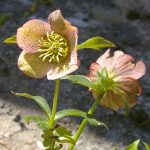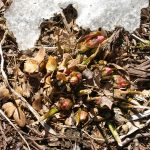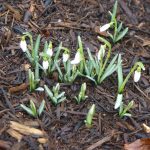designed for the way women work.

Nature’s Own Antifreeze
Category: Presenting "The Curious Gardener"

Have you ever wondered how certain plants are able to withstand sub-freezing temperatures and bloom even with the ground blanketed by snow and ice?
The secret to their longevity lies in compounds known as antifreeze proteins (AFP), which work to protect the plant’s cells from the degenerative effects of freezing temperatures. It may sound like science fiction, but some plants have cells that don’t freeze. Here we’ll take a closer look at nature’s own antifreeze, and reveal some of the plants known to possess them.
Plants aren’t the only living organism to contain antifreeze proteins. Certain animals, fungi and even bacteria also carry these proteins. Scientists believe antifreeze proteins are an evolutionary trait used to help living organisms survive.
Plants carrying antifreeze proteins will typically still develop ice on the outside (extracellular freezing), but the inside will remain unfrozen. From the naked eye, it may appear as if the plant is frozen with ice coating the leaves and stems; however, the cells’ interior structure will remain solid and unaffected by the ice and freezing temperatures.
Hellebores

Hellebores are a group of about 20 herbaceous or evergreen species from the Eurasian genus helleborus. They are one of the earliest blooming perennials and it’s not uncommon to find Lenten rose (helleborus orientalis) emerging through the frost-covered ground. They are able to endure such cold temperatures because of the antifreeze proteins present in their cellular structure. These proteins prevent the inside of the plant from suffering frost and cold damage.
If you plan on growing hellebores in your garden, you’ll want to use caution and avoid touching them with your bare hands because of their toxicity to humans. Prolonged exposure to the skin can result in rash and/or irritation.
Snowdrops (Galanthus)

Another type of plant that’s known to possess antifreeze proteins is the Snowdrop (galanthus). This evergreen perennial gets its name from the milky-white leaves resembling snowdrops that form from a single stem. With an average height of just 4-6 inches, snowdrops are small, but they make wonderful additions to any outdoor garden. One of the reasons why so many people choose to add them to their gardens is because of their ability to bloom early. Snowdrops remind us that Spring is coming!



Hope people will visit the collection at the New York Botanical Garden. They have almost 150 different varieties.
This is for you at Womenswork to consider privately and then perhaps decide to update the information you provide in the article, Nature’s Own Antifreeze. You mention that hellebores are native to the northeastern US. I had looked into their status as natives a few months ago when I was considering buying some. When I read your article I looked again. What I’m seeing is that they are native to Europe and Asia. I was disappointed to learn that because I am focused on putting plants in the ground that are native. I am not a purist in this regard. Since my property had been planted through several decades before I owned it and contained non-natives, I have struck a balance between removing all the non-natives and keeping new plants in the ground as natives. I indulge my enjoyment of non-native summer flowers in pots on my deck. In doing my research about the hellebores I noticed an article from a GA gardener that mentioned in her climate hellebores are making their way toward being invasive plants. I’m in SE PA, very near DE, so I pay attention to what is going on with climate change to the south of us, as it appears through climate change, our climate is moving in that direction.
In reference to Pam Hesler’s question about Helleborus becoming “invassive”….not sure I’d go so far as to say “invassive”….but they are trouping along in my garden and spreading everywhere. I planted “Heritage Mix” about 30 years ago, and they have made a lot more in various places of my garden…as yet, it isn’t a bad thing, and they are so lovely to see in my winter months in Portland, OR. But it should be a consideration for anyone who does not want to have such wayward plants. The flowers should be removed before they can go to see, for sure. And when the starts are little they would need to be plucked out. I do not know about other varieties, but the ones I mention here have multiplied a lot.
Pam, thank you for your comment. We will indeed update our article. I will also look into whether they are considered invasive. I had not heard that and in fact they do not spread in my garden. They are very polite.